Recently, a research team led by Professor Min Qiu from Westlake University achieved a significant breakthrough at the intersection of micro/nanofabrication and bioscience. They successfully created precise micro/nanoscale patterns on the surface of tardigrades—often hailed as the "hardiest creatures on Earth"—and utilized these functional patterns to effectively control their movement. This study expands the boundaries of traditional micro/nanofabrication technology, accomplishing not only functional modifications on living organisms but also precise regulation of microscale biological motion. The findings were published in Nano Letters (selected as a supplementary cover) and Science Bulletin under the titles "Patterning on Living Tardigrades" and "Tattooing water bears: microfabrication on living organisms," respectively.
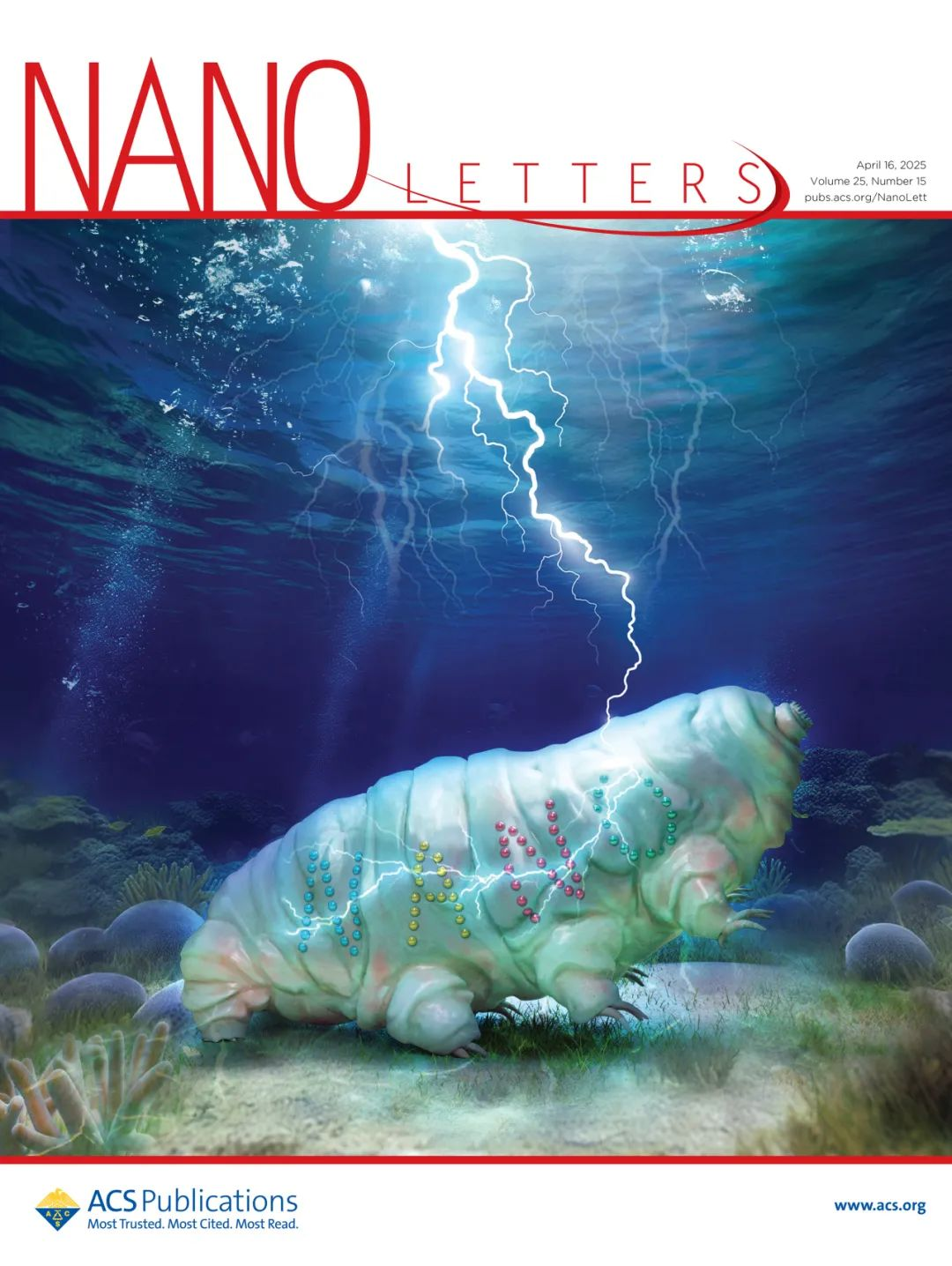
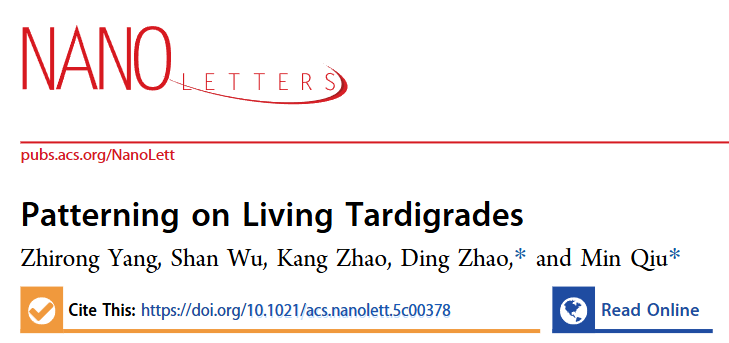
Nano Letters article: https://pubs.acs.org/doi/10.1021/acs.nanolett.5c00378
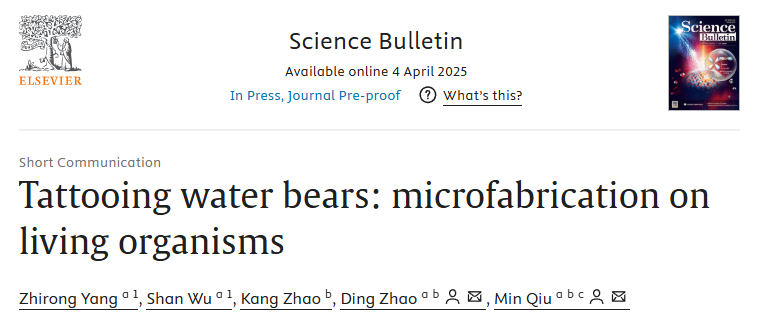
Science Bulletin article: https://www.sciencedirect.com/science/article/pii/S2095927325003615
【Research Background】
Richard Feynman once poetically envisioned the infinite possibilities of the microscopic world, proposing the idea of engraving an entire encyclopedia on the head of a pin. Today, with the rapid advancement of nanotechnology, this vision has become reality. Cutting-edge micro/nanofabrication techniques such as UV lithography, electron-beam lithography, and nanoimprinting now enable the precise construction of high-density, intricate patterns on various inorganic substrates. However, a more challenging scientific question has emerged: Can we transcend traditional substrates and achieve microscale patterning on living organisms?
Despite the growing field of bioelectronics, the stringent conditions of conventional micro/nanofabrication remain incompatible with biological systems. For instance, chemical developers and solvents used in traditional lithography can severely damage living tissues, while the irregular surface morphology of fragile organisms often exceeds the operational limits of standard techniques. The stable integration of functional materials onto living organisms remains a critical scientific challenge.
【Key Achievements】
Recently, Professor Min Qiu’s team at Westlake University’s School of Engineering made a groundbreaking advance in micro/nanofabrication on living organisms, successfully "tattooing" tardigrades. Their findings, published in Science Bulletin and Nano Letters, demonstrate two distinct micro/nanofabrication techniques applicable to living systems.
Tardigrades, colloquially known as "water bears," are renowned as the "hardiest creatures on Earth" due to their extreme survivability. These microscopic organisms can endure temperatures from -273°C to nearly 100°C, as well as extreme dehydration, intense radiation, high pressure, and toxic environments, making them ideal subjects for exploring micro/nanofabrication on biological systems.
In the Science Bulletin study, the team pioneered semiconductor thin-film deposition to create micron-scale "metal tattoos" on tardigrades. Using magnetron sputtering or electron-beam evaporation, researchers deposited metal films onto tardigrades in a cryptobiotic state. Upon revival, the organisms’ movements caused the metal films to fracture naturally, forming distinctive striped patterns. Different metal coatings endowed tardigrades with unique functional properties—for example, magnetic metal coatings enabled them to respond to external magnetic fields, allowing researchers to control their rotation, rolling, and translational motion.
In the Nano Letters study, the team developed a more precise "ice lithography" technique to craft nanoscale "carbon tattoos" on tardigrades. This method involved depositing a uniform nanoscale ice film on cryptobiotic tardigrades, followed by electron-beam exposure to convert specific regions into stable carbon-based structures. Under suitable revival conditions, the tattooed tardigrades successfully resumed activity. Experiments confirmed the carbon structures’ exceptional adhesion, withstanding stretching, solvent immersion, rinsing, and drying. Compared to traditional thin-film deposition, ice lithography enables in situ fabrication, offering superior precision, adhesion stability, and biocompatibility.
【Graphical Abstract】
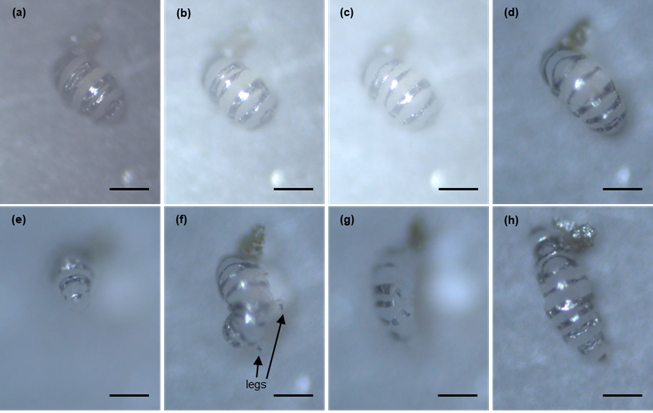
▲ Figure 1. Tardigrades with adhered metal stripe patterns (Scale bar: 100 µm; Source: Science Bulletin)

▲ Figure 2. Magnetic-field-controlled manipulation of tardigrades (Scale bars: b-i, 70 µm; j-l, 200 µm; Source: Science Bulletin)
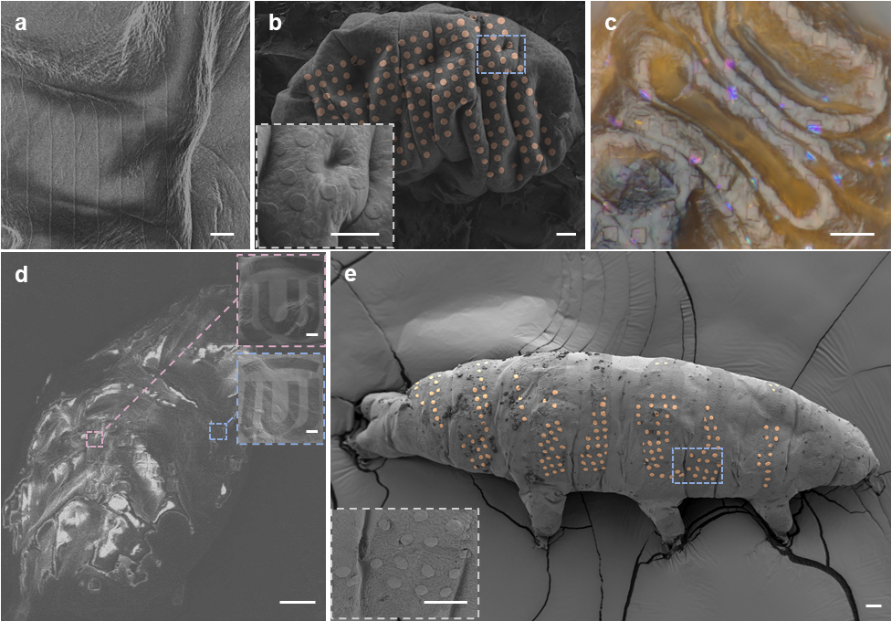
▲ Figure 3. Characterization of carbon-based micro/nanostructures on tardigrades via ice lithography (Scale bars: a, 2 μm; b, c, e, 10 μm; d, 20 μm [inset: 1 μm]; Source: Nano Letters)
【Conclusions and Future Prospects】
This study pioneers micro/nanofabrication on living organisms—particularly tardigrades—providing new tools for studying extremophile adaptability and demonstrating the vast potential of merging micro/nanotechnology with bioscience. Future work may employ advanced fabrication methods to create even finer patterns on specific biological regions, enabling precise control of life activities via optical, electrical, thermal, or other physical fields. Applications span bioelectronic devices, biomimetic systems, and living microrobotics.
The first author of this study is Zhirong Yang, a Ph.D. candidate at Westlake University. The corresponding authors are Researcher Ding Zhao (Westlake Institute for Optoelectronics) and Chair Professor Min Qiu (Westlake University). This research was supported by the National Natural Science Foundation of China.
Source: Westlake University School of Engineering (SOE) Official WeChat Account
https://mp.weixin.qq.com/s/8_EjVssZhW4oOU-b4MM13w

